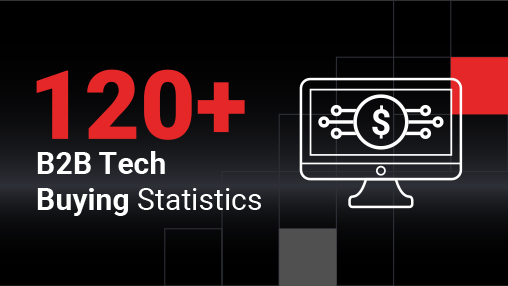Understanding the complexities of the B2B tech buying process today has never been more crucial. What triggers a tech search among B2B professionals, and how are final purchasing decisions shaped? Our B2B Tech Buying Behavior 2024 Report dives deep into these questions, revealing 120+ compelling statistics that shed light on current trends within the Insights for Professionals (IFP) community – a platform for business decision makers committed to sharing knowledge and advancing industry practices.
This blog aims not only to offer a comprehensive overview of the intricate journey B2B tech buyers undertake but also to arm you with actionable insights to refine your marketing strategies, particularly in demand generation. From exploring triggers for technology research to budgets considerations, we decode the behaviors and preferences that guide technology purchasing decisions.
Understanding these behaviors is crucial. From assessing the impact of cost, to the recognition of brands, and the relevance of educational content, each insight we’ve gathered represents a strategic advantage for engaging with your buyers more effectively.
In this post, we’ll explore the following:
- Understanding the B2B tech buyer profile
- Triggers for technology research
- Content consumption habits of B2B buyers
- Vendor interactions and expectations
- The pivotal role of trust and credibility in B2B tech sales
- Budget considerations and trends in B2B tech purchases
The B2B tech buyer profile
Inbox Insight surveyed 800+ B2B Buyers across the USA and EMEA regions spanning various industries.
Seniority level
Directors/VPs represent the largest segment at 32%, followed by managers at 22%.
Department and region
The majority of respondents work in Information Technology departments (76%), with a significant portion based in the US (57%).
Company size
Organizations with 500 to 999 employees are most represented (26%), followed by firms with 1000 to 2499 employees (17%).
Industry
The software/technology sector stands out as the leading industry (36%), followed by finance and banking (12%).
Role within the buying team
Ultimate decision-makers wield significant influence (48%), with influencers also playing a substantial role (22%).
This sample offers a credible snapshot of B2B tech buyers’ characteristics and their roles within organizations, providing insights into key demographics and decision-making dynamics.
Chapter 1: The buying journey
Understanding the triggers that prompt buyers to explore new vendors is crucial, so what are the key motivations behind decision-makers’ quests for alternative solutions?
a. Triggers for researching new tech vendors
- Over half (56%) of B2B buyers research new vendors because the new product is more feature-rich than their current solution. This suggests that product capabilities are a key driver of vendor selection for many organizations.
- Slightly over half (51%) of respondents cited poor integration with their existing tech stack as a reason to explore new vendors.
- Another 51% of decision-makers said they research new vendors when they have a business pain point that their current technology cannot solve. This indicates that unmet needs are a major catalyst for vendor changes in the B2B space.
- 42% of buyers reported poor customer service from their current vendor as a trigger to seek out alternatives. This highlights the importance of exceptional client support in retaining B2B customers.
Have content and demand generation programs that aim at each of these needs to trigger increased research activity.
b. Research and evaluation process
How crucial is it for vendors to understand the thorough research and evaluation processes undertaken by B2B decision-makers, aiming to capture their attention and trust?
Decision making involvement
Key role in technology selection:
- B2B decision-makers are heavily involved in the technology selection process, with 75% reporting they research and recommend solution providers, and another 75% evaluating technical requirements. Additionally, 70% of respondents determine the business need for a new technology or solution. While over half (58%) have sign-off and approval authority for the purchase.
These insights highlight the critical role B2B buyers play in identifying, evaluating, and approving new technologies for their organizations. Marketers targeting this audience should focus on delivering compelling thought leadership and product information to support the research and evaluation stages, while also ensuring their sales teams are equipped to navigate the approval process.
Annual purchase involvement:
48% of B2B decision-makers are involved in 10 or more technology purchases per year, with 24% handling more than 15 purchases annually
- A notable one-third (32%) of respondents are involved in 5 to 9 technology purchases per year, demonstrating the significant purchasing power of B2B buyers.
- Just 18% of B2B buyers are involved in a relatively low number of 2 to 4 technology purchases annually, highlighting the high volume of products and services these decision-makers must evaluate.
- A mere 2% of survey participants are only responsible for a single technology purchase per year, indicating that B2B buyers typically juggle multiple purchasing decisions as part of their roles.
Stakeholder involvement:
- Over 80% of B2B buyers involve 4 or more stakeholders in their technology purchasing decisions, with 31% involving 4 to 8 members and 29% involving 8 to 12 members.
- 18% of buyers only involve 1 to 4 stakeholders in their technology purchase decisions, indicating a more streamlined decision-making process for some organizations.
- 11% of buyers involve more than 20 stakeholders in their technology purchases, representing a highly complex and collaborative decision-making process.
- 10% of buyers involve 12 to 19 stakeholders when making technology purchasing decisions, highlighting the increasingly cross-functional nature of B2B technology investments.
These statistics provide valuable insights for B2B marketers, demonstrating the complexity and collaborative nature of technology purchases within many organizations. Understanding the typical number of stakeholders involved can help shape more effective marketing and sales strategies to engage the right decision-makers.
Buying process details
Average buying process duration:
- Over one-third (38%) of B2B buyers report an average technology purchase process of 1 to 3 months, indicating a relatively quick buying cycle for many organizations.
- A sizable portion (34%) of decision-makers have a 3 to 6 month average buying process for technology purchases, suggesting a moderate timeline for a significant segment of the B2B market.
- 14% of respondents have an average buying process for technology that spans 6 to 12 months, highlighting the more extended decision-making timelines some B2B buyers require.
- Only 7% of buyers complete a technology purchase in less than 1 month, demonstrating that the majority of B2B organizations engage in a more drawn-out evaluation and approval process before finalizing a technology investment.
Time dedicated to research:
- A third (33%) of B2B buyers dedicate 3-9 hours per month to researching new technologies they are considering purchasing.
- Just over a quarter (26%) of decision-makers spend 1-3 hours per month researching potential new technology solutions.
- 23% of respondents invest 10-19 hours per month into researching new B2B technologies they may buy.
- A small but significant portion (9%) of B2B buyers spend 20-40 hours per month researching new technological offerings before making a purchasing decision.
These statistics demonstrate the substantial time and effort B2B buyers are willing to dedicate to thoroughly researching new technologies before investing in them. This highlights the importance for B2B marketers to provide extensive, valuable information to potential customers throughout the lengthy research and consideration process.
Information sources
Research habits:
- A significant 42% of respondents reported consulting 4-6 sources of information when researching a purchase, indicating their thorough and data-driven approach to decision-making.
- Over one-third (35%) of B2B buyers examine 7-10 sources of information before making a purchase decision, showcasing the depth of their research process.
- A noteworthy 9% of respondents go to great lengths, reading or watching 10-15 sources, to gather comprehensive insights before finalizing a purchase.
- While most B2B buyers conduct extensive research, a small portion (8%) rely on 1-3 sources when making a purchasing decision, potentially representing a more time-sensitive segment of the market.
Information sharing preferences:
- B2B buyers are increasingly selective about the brands they share their personal information with. Over half (52%) of respondents expressed a preference for providing their details only to brands they know and trust. Meanwhile, 22% said they have a select few sources they’re willing to share their information with. These findings suggest that B2B decision-makers are becoming more cautious about giving up their personal data, prioritizing trust and familiarity over convenience.
- Interestingly, 19% of respondents indicated they’re willing to download content from anywhere, regardless of whether it’s gated or not. This suggests that a sizeable portion of B2B buyers are still open to accessing content without requiring a personal information exchange. However, the survey also reveals that only 6% of respondents “very rarely/never” download gated content, underscoring the importance of content personalization and lead capture for B2B marketers.
Research preferences
What channels do B2B buyers trust the most when researching business challenges?
- 60% of B2B buyers prefer to use software comparison websites when researching business challenges, making it the most popular information source.
- Slightly over half (52%) of decision-makers rely on business or industry news sites to help them navigate their challenges, indicating the importance of thought leadership content.
- Generative AI tools like ChatGPT are used by nearly half (46%) of respondents when conducting research, highlighting the growing influence of AI-powered information sources.
- Only 17% of B2B buyers turn to whitepaper libraries, newsletters/email bulletins, and case studies when looking to address their business needs, suggesting these traditional content formats may be less engaging for modern buyers.
These statistics provide valuable insights into the preferred research habits and information sources of today’s B2B buyers, which can help marketers optimize their content and channel strategies to better reach and influence this audience.
Evaluation preferences
What channels do B2B buyers trust the most when evaluating the technical requirements of a solution?
- B2B decision-makers primarily trust software comparison websites, with 55% of respondents relying on this source. Closely following are product review sites (46%) and business/industry news sites (45%), indicating that B2B buyers value authoritative and objective information from third-party sources.
- Interestingly, 38% of respondents trust generative AI platforms, such as ChatGPT, when assessing technical requirements.
- 36% of B2B buyers rely on vendor websites and blogs/articles, suggesting that while they value independent sources, they also recognize the importance of understanding the vendor’s perspective.
- 35% of respondents trust independent research analysts, demonstrating the continued importance of expert opinions and in-depth analysis in the B2B decision-making process.
Shortlisting preferences
What channels do B2B buyers trust the most when shortlisting brands for a purchase decision?
- Over half (52%) of buyers trust software comparison websites when shortlisting brands for a purchase decision, making it the most trusted source of information.
- 45% of respondents rely on product review sites when evaluating potential vendors, highlighting the importance of online reviews in the B2B buying process.
- Generative AI tools like ChatGPT are trusted by a notable 34% of B2B decision-makers.
- Only 12% of buyers trust newsletters and email bulletins as a source of information when making purchasing decisions, significantly less than other digital channels like websites and review sites.
These statistics provide valuable insights into the information sources that B2B buyers find most credible and trustworthy when researching and evaluating potential vendors, which can help marketers better tailor their content and outreach strategies.
c. Decision-making factors
Exploring the decisive factors influencing B2B technology purchases provides valuable insights into how vendors can effectively engage decision-makers. How can vendors strategically leverage these insights to enhance their approach and resonate more effectively with prospective buyers?
Cost impact on purchase decision
Cost influence:
- 40% of respondents stated that cost has a considerable impact on their final purchase decision, highlighting the significant influence of pricing for B2B buyers.
- 11% of buyers described cost as having a “hugely” important impact on their purchasing choices, demonstrating the critical role affordability plays in the B2B decision-making process.
- Over one-third (34%) of decision-makers indicated that cost has a somewhat significant influence on their purchasing choices, reinforcing the importance of offering competitive and transparent pricing to appeal to B2B audiences.
Brand recognition and engagement
Content engagement:
- A significant 90% of respondents either agreed (47%) or strongly agreed (43%) that they are more likely to engage with content from a brand or vendor they recognize and trust.
- A mere 6% of decision-makers neither agreed nor disagreed with the statement, suggesting that the majority of B2B buyers place a strong emphasis on brand trust when consuming content.
Shortlisting influence:
- The survey results underscore the critical importance B2B buyers place on brand recognition and trust when evaluating vendors. Specifically, 52% of respondents agreed with this sentiment, with an additional 34% expressing strong agreement. This indicates that a substantial majority—over 85%—of decision-makers are inclined to shortlist vendors they recognize and trust.
Higher funnel touchpoints will increase your consideration in the buying process.
These findings underscore the importance for B2B marketers to invest in building a strong, trustworthy brand to improve their chances of being shortlisted by potential customers.
Technology integration importance
Tech integration:
- 90% of B2B buyers either agree or strongly agree that a vendor’s ability to integrate with their existing technology significantly influences their decision to add them to the shortlist. This statistic underscores the critical role of technology integration in the evaluation process for B2B decision-makers. It reflects a growing preference among buyers for solutions that seamlessly integrate with their current tech stack, emphasizing the importance for B2B marketers to prioritize interoperability in their product offerings.
Vendor evaluation process
Number of vendors considered:
- B2B buyers evaluate multiple vendors when choosing new technology solutions. 49% consider 2 to 4 vendors, 33% evaluate 5 to 7, and 13% assess 7 to 10 providers. Interestingly, only 4% review more than 10 options.
Procurement process
RFP requirement:
- A significant majority, 75% of respondents, are required to go through an RFP (Request for Proposal) process or get multiple prices from their procurement department.
The data suggests that B2B marketers need to be prepared to participate in rigorous RFP procedures alongside competitors to successfully engage with the majority of their potential customers.
Recommended reading: The B2B Decision Making Unit (DMU): The Real Faces of Persuasion
Chapter 2: Content consumption habits
Understanding how buyers engage with and consume content is important for shaping effective strategies today. Here’s a snapshot of current trends:
Social platforms for work content
- Three-quarters (74%) of respondents use LinkedIn for work-related content, making it the dominant social platform among B2B buyers.
- Over half of decision-makers use Facebook (57%) and YouTube (57%) for their professional content needs, indicating the importance of visual and video-based content in B2B.
- Nearly half (47%) of respondents turn to X for work-related social engagement, highlighting the platform’s continued relevance for B2B marketers.
- One-third (32%) of B2B buyers use the emerging social media channel TikTok for professional purposes, suggesting the growing influence of short-form video content.
Time of content consumption
- A significant majority (70%) of B2B buyers consume work-related content while they are at work, indicating that during office hours is a prime time to reach this audience.
- Over 40% of respondents engage with work-related content in the morning before work (41%) and in the evening after work (40%), suggesting that B2B marketers should consider distributing content at the start and end of the workday.
- Approximately 30% of B2B decision-makers report consuming work-related content during their commute (30%), highlighting the importance of mobile-friendly content for this audience.
- While only 6% of buyers engage with work content on holiday, nearly a quarter (24%) do so on weekends, revealing that B2B marketers should adopt an “always-on” approach to reach their target audience.
Cookie management preferences
- A significant portion (43%) of respondents simply select “Accept all” when managing cookies on websites, indicating a preference for convenience over granular control.
- Over one-third (39%) of decision-makers prefer to manually choose which cookies to accept, demonstrating a desire for more transparency and control over their data.
- Interestingly, 13% of B2B buyers surveyed reject all cookies when possible, suggesting a growing awareness and concern around data privacy.
- Despite the prevalence of cookie acceptance, 6% of respondents use an ad blocker, potentially limiting the effectiveness of cookie-based targeted advertising for B2B marketers.
These statistics provide valuable insights into how buyers manage their online privacy and preferences, which B2B marketers should consider when developing their digital strategies and tactics.
Preferences for webinar vs. podcast content
Understanding how buyers engage with different content formats is crucial for optimizing engagement strategies. Here’s a breakdown of preferences and habits regarding webinars and podcasts:
Webinar vs. podcast engagement
- 40% of B2B buyers report being more likely to engage with webinar content compared to podcast content.
- One-third (34%) of respondents indicated they engage with webinar and podcast content at about the same rate.
- Nearly a quarter (23%) of decision-makers state they are more likely to engage with podcast content over webinar content.
These statistics provide valuable insights into the content preferences of B2B buyers. The data suggests that webinars remain an effective engagement tool, with over 39% of respondents favoring this format.
However, a sizable portion, almost one-quarter, are more drawn to podcasts. B2B marketers should consider this split in preferences when allocating resources across their content strategy.
Webinar engagement habits
- Nearly half (49%) of respondents engage with webinar content on-demand, indicating a preference for flexible, self-paced viewing.
- Over one-third (40%) of B2B buyers participate in webinars live on the day they are broadcast, demonstrating the continued appeal of real-time interaction.
- A significant 5% of decision-makers sign up for webinars but end up forgetting to watch them, highlighting the importance of effective registration and reminder strategies.
Understanding these behaviors enables marketers to enhance engagement and deliver content in formats that resonate with their audience’s preferences and schedules.
Expect to see a lot of your long term value from webinar programs through on-demand consumption. Using that content for syndication and lead generation will lengthen its lifespan.
Information preferences for vendor evaluation
Knowing what information influences vendor evaluation is vital for B2B marketers seeking to meet the needs of decision-makers. Here’s a look at the preferences and expectations surrounding vendor evaluation:
Helpful information for vendor evaluation:
- More than half (59%) of B2B buyers find product sheets the most helpful in evaluating shortlisted vendor solutions.
- Over half (53%) of decision-makers rely on case studies when assessing potential vendors.
- Almost half (49%) of respondents use competitor comparison sheets to aid their vendor selection process.
- 46% of B2B buyers seek out detailed pricing breakdowns when evaluating vendor solutions.
These statistics highlight the key information that B2B buyers find most valuable when shortlisting and assessing potential vendors.
Vendors should ensure they provide comprehensive product details, compelling case studies, competitive comparisons, and transparent pricing to address the needs of this influential audience.
Expectations for personalization:
- More than half (51%) of decision-makers want a high or very high level of personalization when evaluating B2B purchases.
- 40% of B2B buyers expect some level of personalization when researching and buying a B2B solution.
A significant majority (91%) of B2B buyers expect at least some level of personalization during the purchasing process. Therefore, B2B marketers should prioritize personalization strategies to effectively meet the expectations and needs of their target audience. One effective tactic to achieve this is account-based marketing.
Chapter 3: Vendor interactions and expectations
Gaining insight into how buyers anticipate vendor engagement is key for developing impactful outreach strategies. Here’s a detailed exploration of their preferences and expectations:
Expectations of vendor contact:
- Over a quarter (28%) of B2B buyers expect a vendor to contact them when they request more information, indicating a preference for an active role in initiating vendor outreach.
- One in four (25%) decision-makers say they would expect a vendor to reach out if they take an action on the vendor’s website, such as browsing product pages or engaging with content.
- Nearly 1 in 5 (19%) buyers expect vendors to contact them when they begin reading the vendor’s online content, suggesting the importance of a strong content marketing strategy.
Preferred methods of contact:
Email nurture follow up is still the most popular tactic, but mix in multiple channels to increase conversion chances.
- The vast majority (83%) of B2B buyers prefer for sellers to reach out to them via email, indicating that email remains a highly effective channel for B2B outreach.
- Nearly half (49%) of respondents are open to receiving phone calls from sellers, suggesting that a personalized, direct approach can still resonate with many B2B buyers.
- Almost a quarter (24%) of B2B decision-makers are receptive to instant messenger as a means of seller outreach, highlighting the growing importance of real-time, conversational engagement.
Educational support expectations:
- Over 7 in 10 (72%) B2B buyers expect one-on-one consultations with subject matter experts from their vendors. This highlights the importance of high-touch, personalized support for B2B decision-makers.
- Nearly half of respondents (45%) seek thought leadership content from their B2B vendors, indicating a strong appetite for educational resources that provide valuable industry insights.
- 44% of B2B buyers say they expect access to practitioner communities from their vendors, suggesting the need for peer-to-peer learning and networking opportunities.
- 42% of decision-makers request product demos, underscoring the importance of hands-on experience when evaluating B2B solutions.
These insights into buyer expectations are essential for B2B marketers aiming to build meaningful relationships and effectively support decision-makers throughout their purchasing journey.
Chapter 4: The role of trust and credibility
Why is understanding the factors that enhance trust essential for establishing credibility in the eyes of B2B buyers? Here’s a closer look at key influencers and preferences shaping trust:
Factors increasing trust
Valuable content from vendors
- 88% of B2B buyers either agree or strongly agree that they trust a brand more if they receive valuable content from that vendor. This underscores the importance of providing high-quality, informative content to build trust.
Affiliation with industry experts or influencers
- 75% of decision-makers trust a brand more if it is affiliated with industry experts or influencers. This highlights the significant role of industry expertise and influencer credibility in building trust with B2B decision-makers.
Recommended reading: Why B2B Buyers Trust Brands That Partner with Industry Experts
Engage with Key Opinion Leaders and Creators with a community in your category.
Trustworthiness of online information
- 41% of B2B tech buyers agree that they struggle to find trustworthy online information about technology solutions. This indicates a notable segment of B2B decision-makers still face challenges cutting through the clutter to identify reliable sources.
Preference for third-party content
- 44% of B2B buyers trust impartial third-party content more than vendor-provided information about business challenges and technology solutions. An additional 24% strongly agree with this sentiment, reinforcing the preference for unbiased perspectives in decision-making processes.
Sponsor publishers and analysts to co-brand content in demand gen programs
Chapter 5: Budget considerations and trends
Understanding technology budgets is crucial for B2B marketers. Here’s a detailed overview of budget allocations and emerging trends shaping financial decisions:
Technology purchase budgets
Average budget per technology purchase
- Over half of B2B buyers have significant technology purchase budgets, with 28% having an average budget ranging from $100,000 to $500,000, and 22% having an average budget exceeding $500,000. This demonstrates the substantial financial resources allocated by many organizations towards technology investments.
Largest technology purchase last year
- Three-quarters of B2B decision-makers spent up to $500,000 on their largest technology purchase last year, with 10% spending more than $1 million. This underscores the growing importance and value that buyers place on robust, enterprise-class solutions to drive their businesses forward.
Annual departmental technology budget
- Over one-fifth (21%) of B2B buyers have an annual technology budget of $500,000 to $1,000,000 for their department. Nearly 30% of buyers have a budget of $1 to $5 million, while 13% of decision-makers have a technology budget exceeding $5 million.
These statistics provide valuable insights into the scale of technology budgets among B2B buyers, highlighting their significant spending power.
This information can help B2B marketers better understand the financial resources available to their potential customers and inform their sales and marketing strategies accordingly.
Tech budget trends
Changes in budget
- Over 50% of B2B decision-makers reported that their budget has increased or greatly increased compared to last year, indicating a significant opportunity to capture new technology purchases from potential buyers.
Expected changes in budget next year
- More than half of buyers (57%) anticipate an increase or significant increase in their budgets, signalling a substantial ramp-up in tech requirements for many organizations.
Ready to identify, educate, and convert your most qualified buyers?
Knowing how to leverage the buyers journey can maximise your demand generation results. We regularly conduct research like this, along with analysing intent data, to understand how to engage your target audience.
Improve your prospect targeting with Inbox Insight’s Demand Generation service. Utilizing Insights for Professionals platform, we use comprehensive funnel tactics designed to not only reach but fully engage your ideal customers. Achieve impact within your key accounts and expedite your sales process.






